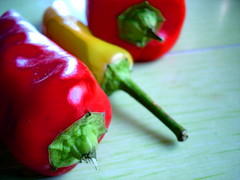Relatively Quick Breads 1: Sally Lunn
 fig. a: sliced Sally Lunn
fig. a: sliced Sally Lunn
Suddenly, I awoke from my slumber. After years and years where I baked virtually no bread, aside from the occasional batch of corn bread, I've baked two--count 'em, two--loaves in under a week. I'm sure Michelle thought it would never happen. For years she's been listening to me tell tales of my days as a "professional bread baker" in London, days when I manned the ovens of a take-out & bakery on Portobello Road, but, no, nothing ever came of it. Not one single, solitary loaf. "Mmm-hmm. Yeah, I know, honey," she'd say. "You were famous for your rice bread..." The curse is now broken, though, and all it took was a little help from Sally Lunn, and a little patience.
I'm something of an amateur of Southern culture, but before reading The Lee Bros. Southern Cookbook I had absolutely no idea Sally Lunn was a Southern thing, "the South's challah," as they put it. I'd encountered my fair share of spoonbread in my crisscrossing of the South, but never Sally Lunn. My only previous experience with Sally Lunn was in its birthplace, Bath, where the local tourist board makes sure that even if you arrive knowing nothing of Sally Lunn, you leave knowing every apocryphal and vaguely saucy detail of her life--her French heritage, her development of a "rich, round, and generous" bread which is now known as "the Sally Lunn Bun," her peddling of her "hot buns through the streets of Bath" and her rise to fame because of them, etc.--preferably having paid a visit to "Sally Lunn's house" along the way. But the Lee Bros. cookbook not only includes a recipe for Sally Lunn, it features it prominently throughout the text, mentioning it in connection to at least half a dozen other recipes, including everything from their Grilled Pimento Cheese Sandwich to their She-Crab Soup, and when I looked it up I found out they were right: it is a Southern thing.
 fig. b: United States of Sally Lunn
fig. b: United States of Sally Lunn
It's not as easy to make as corn bread (and it's not nearly as contentious, corn bread being a serious affair in the South), and therefore it's in no position to unseat corn bread's dominance in their repertoire of breads (corn bread is mentioned in connection to at least ten other recipes), but it's versatile and they're clearly very fond of it.
But even all that wasn't enough to inspire me to actually bake a loaf of Sally Lunn. Strangely, what it took was word that there were problems with the Lee Bros. recipe. For some reason, hearing that the recipe might be flawed was what got me back into the bread-making business. If there was something wrong with Sally, I wanted to know just what, and whether anything could be done help the old gal along.
The word was that the problems with the Lees' Lunn had largely to do with faulty proofing times, and, sure enough, when we took a look there were things amiss. You see, there's no question that when someone tells you that a bread's second proofing stage, a stage which is supposed to result in the dough doubling in size, will take place in "about 12 minutes" that there's something ambitious about that claim. The power of yeast is something of a miracle, as we all know, but there's no need to get overexcited. Then again, it does get awfully hot down in Charleston, but "12 minutes"? The recipe had specified that the dough needed to double in size during this proofing stage, though, so we decided to give the dough all the time it needed to reach that point. And the same thing held for the first proofing: the Lees had rather optimistically suggested that this stage would take "about 35 minutes," but again what was crucial was that the dough double in size. Pretty much everything else about the recipe seemed kosher. We could tell because we checked it against a couple of other Sally Lunn recipes we just happed to have kicking around (who knew?), such as the one out of Marie Nightingale's Out of Old Nova Scotia Kitchens (!--Sally Lunn may be a Southern thing, but it's also apparently a Maritimes thing),*
 fig. c: Out of Old Nova Scotia Kitchens--mmm!
fig. c: Out of Old Nova Scotia Kitchens--mmm!
and for the most part the recipes were identical. The only potentially major flaw we could see with the Lee Bros. recipe had to do with the final baking time. Now, I guess it's also possible that a 350º oven in Charleston runs hotter than a 350º oven in Montreal, but when we compared it with our other recipes the Lees' recipe was off by about 15-25 minutes when it came to baking time and that was a discrepancy we just couldn't account for. You never know, though, right? Maybe those wily Lees had found a way to streamline the process. The only way to know for sure was to roll up my sleeves and get to work, so that's what I did.
Sally Lunn
1 cup whole milk
1 package (1/4 ounce, or 2 1/4 tsp) active dry yeast, at room temperature
8 tbsp butter (1 stick), softened
1/3 cup sorghum molasses, cane syrup, or honey
3 large eggs, at room temperature
4 cups (16 ounces) sifted unbleached all-purpose flour, at room temperature
1 tsp salt
Heat the milk over medium heat in a small saucepan, stirring occasionally, until the temperature reads 105 degrees on a candy thermometer. Turn off the heat. Pour the yeast into the milk, whisk gently with a fork to dissolve, and let stand until tiny bubbles form on the surface of the milk, 5 to 10 minutes.
With an electric mixer, cream 7 tbsp butter with the molasses, syrup, or honey [we used honey] in a large bowl until smooth, glossy, and slightly fluffy, about 2 minutes. Add the eggs, one at a time and beat until the mix takes on a café-au-lait-like color (if you use honey [like we did], it will be more of a creamy light yellow color).
In a medium bowl, sift the flour with the salt. Add the flour mixture and the milk and yeast mixture to the egg mixture alternately, one fourth at a time, mixing well with a wooden spoon after each addition, until all the flour has been incorporated and the dough comes together. Stir for a few minutes to ensure a smooth consistency.
Mark the level of the top of the dough on the outside of the bowl with a dab of butter or flour. Cover the dough with a clean dish towel or a piece of plastic wrap and let it rise in a warm place. When the dough has doubled in size, about 35 minutes if you live in Charleston and more like 1 1/2 hours if you live in Montreal, transfer it to a clean, flat surface and punch it down. Beat it with your fist 30 times.
Butter an 8 1/2-x-4 1/2-inch loaf pan with the remaining butter (1 tbsp). Transfer the dough to the loaf pan and pat it evenly into place. Mark the level of the top of the dough on the outside of the pan with another dab of butter or flour. Set in a warm place to rest.
Preheat the oven to 350 degrees F. When the dough has doubled in size again (about 12 minutes in Charleston, about 1 hour in Montreal), bake on the middle rack for 35 minutes if you live in Charleston or 50-60 minutes in Montreal, or until the top is a deep golden brown and the loaf is cooked through. Cool the bread in its pan on a rack for 10 minutes, then invert the pan and remove the loaf. Allow the loaf to cool at least a little bit longer (say, 10 minutes). Slice with a serrated bread knife while warm, or let cool completely on the rack.
Makes 1 loaf; enough for 6 sandwiches and a healthy amount of toast.
[recipe based largely on the one found in The Lee Bros. Southern Cookbook, with a little help from Marie Nightingale]
So, yes, we too found some stumbling blocks in the Lees' otherwise classic recipe, but a few adjustments and the recipe turned out perfectly. The only major adjustment, really, was the baking time, but, like every other recipe, the bottom line is, "if it ain't done, it ain't done." We took our loaf out after 35 minutes and it looked golden on top, but the loaf was clearly still structurally unsound: it was wobbly and needed to bake some more. 20 minutes later, though, it had firmed up nicely and the crust was now a gorgeous deep golden brown.
I sliced off a couple of pieces while the loaf was still warm and slathered them with butter (yes, that's right, more butter) and some of Michelle's strawberry jam
 fig. d: god bless Sally Lunn, strawberry jam, and butter
fig. d: god bless Sally Lunn, strawberry jam, and butterand the ensemble was like cake, maybe better. Later, that Sally Lunn made for great toast and, as the Lees had promised, a wickedly good grilled cheese sandwich.
Q: a) When I bake my own loaf will my slices of Sally Lunn come out looking like a map of France like yours did, and b) is that the final, incontrovertible proof that Sally actually did hail from France?
A: Uh: a) Not necessarily, and b) No.
All I know is that many of the best things in life take time, and relatively quick breads appear to be no exception.
aj
* Incidentally, this is a book Michelle's particularly fond of (which is why I've reproduced its cover). She often imagines herself being Marie Nightingale, sitting in front of her Old Nova Scotia fireplace with her cat and her knitting, gently rocking Junior to sleep, a cauldron of Scotch Barley Broth simmering over the fire. Why? You'd have to ask her.





























